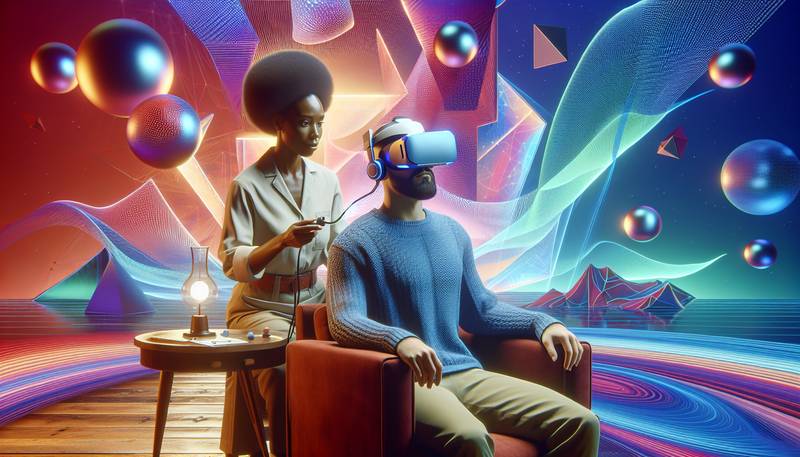The Impact of Virtual Reality on Mental Health Therapies

The Impact of Virtual Reality on Mental Health Therapies
Virtual reality (VR) has been making waves in the tech industry for years now, but its impact on mental health therapies is just beginning to be explored. VR has the potential to revolutionize the way we approach mental health treatment, offering new and innovative ways to help those struggling with a variety of mental health issues. In this article, we will explore the ways in which VR is changing the landscape of mental health therapies and the potential benefits it offers to both patients and therapists.
What is Virtual Reality?
Before we dive into the impact of VR on mental health therapies, let's first define what virtual reality is. VR is a computer-generated simulation of a 3D environment that can be interacted with in a seemingly real or physical way by a person using special electronic equipment, such as a headset with a screen inside or gloves fitted with sensors.
How is VR Being Used in Mental Health Therapies?
VR is being used in a variety of ways in mental health therapies. One of the most common uses is in exposure therapy, where patients are gradually exposed to their fears or traumas in a controlled and safe virtual environment. VR is also being used in cognitive-behavioral therapy, where patients can practice social skills, relaxation techniques, and other coping mechanisms in a virtual setting. Additionally, VR is being used in mindfulness and meditation practices, allowing patients to immerse themselves in peaceful and calming environments.
Exposure Therapy
One of the most well-known uses of VR in mental health therapies is in exposure therapy. This type of therapy is often used to treat phobias, anxiety disorders, and post-traumatic stress disorder (PTSD). By using VR, therapists can create a controlled environment where patients can confront their fears or traumas in a safe and controlled manner. This can help patients gradually become desensitized to their fears and learn how to cope with them in real-life situations.
"VR allows us to create environments that are otherwise impossible to replicate in real life, making it a valuable tool for exposure therapy," says Dr. Sarah Smith, a clinical psychologist specializing in anxiety disorders.
Cognitive-Behavioral Therapy
VR is also being used in cognitive-behavioral therapy (CBT), which focuses on changing negative thought patterns and behaviors. By using VR, therapists can help patients practice social skills, assertiveness, and other coping mechanisms in a virtual setting. This can be especially helpful for patients who struggle with social anxiety or other social phobias, as it allows them to practice these skills in a safe and controlled environment before applying them in real-life situations.
Mindfulness and Meditation
VR is also being used in mindfulness and meditation practices, allowing patients to immerse themselves in peaceful and calming environments. This can be especially helpful for patients dealing with stress, anxiety, or depression, as it can help them relax and focus on the present moment. VR can also help patients practice mindfulness and meditation techniques in a more engaging and interactive way.
The Benefits of VR in Mental Health Therapies
There are several potential benefits to using VR in mental health therapies. One of the biggest benefits is that it offers a safe and controlled environment for patients to confront their fears and traumas. This can help patients feel more comfortable and willing to engage in therapy, as they know they are in a safe and controlled setting. Additionally, VR can offer a more engaging and interactive experience for patients, which can help increase their motivation and participation in therapy.
Another benefit of VR in mental health therapies is that it can offer a more personalized and tailored approach to treatment. Therapists can customize the virtual environments and scenarios to meet the specific needs and goals of each patient, making it a more effective and targeted treatment option. VR can also offer a more immersive experience, which can help patients feel more connected to the therapy process and more invested in their treatment.
The Future of VR in Mental Health Therapies
The future of VR in mental health therapies looks promising. As technology continues to advance, VR will likely become more accessible and affordable for both patients and therapists. Additionally, as research continues to explore the potential benefits of VR in mental health therapies, we will likely see more innovative and effective applications of VR in the field of mental health.
"The potential of VR in mental health therapies is vast, and we are just beginning to scratch the surface of what is possible," says Dr. Smith. "I am excited to see how VR will continue to shape the future of mental health treatment."
In conclusion, VR is changing the way we approach mental health treatment, offering new and innovative ways to help those struggling with a variety of mental health issues. From exposure therapy to mindfulness and meditation, VR is offering a safe, controlled, and immersive experience for patients. The future of VR in mental health therapies is bright, and we can expect to see more exciting advancements in the coming years.


